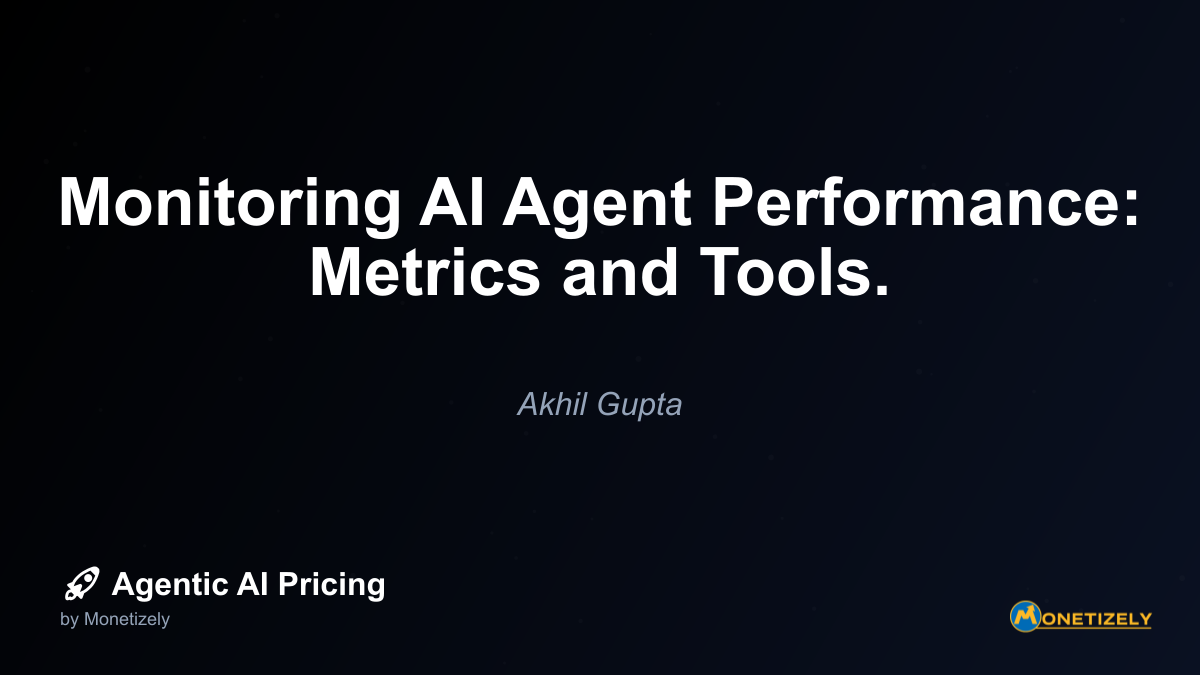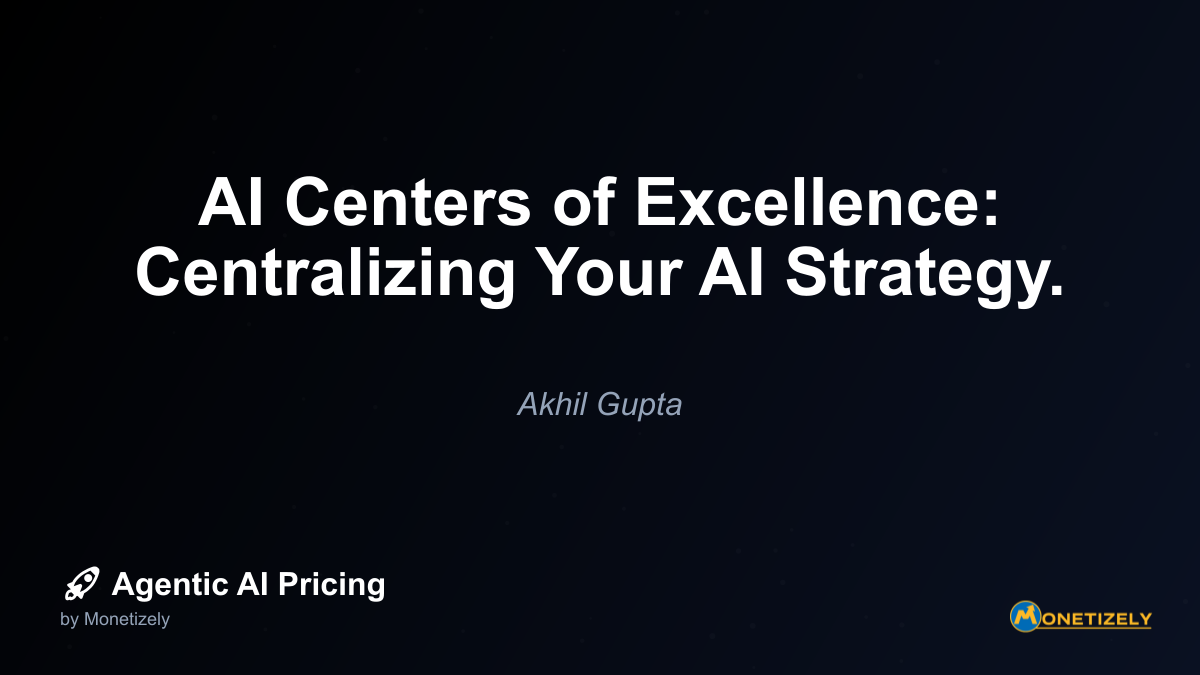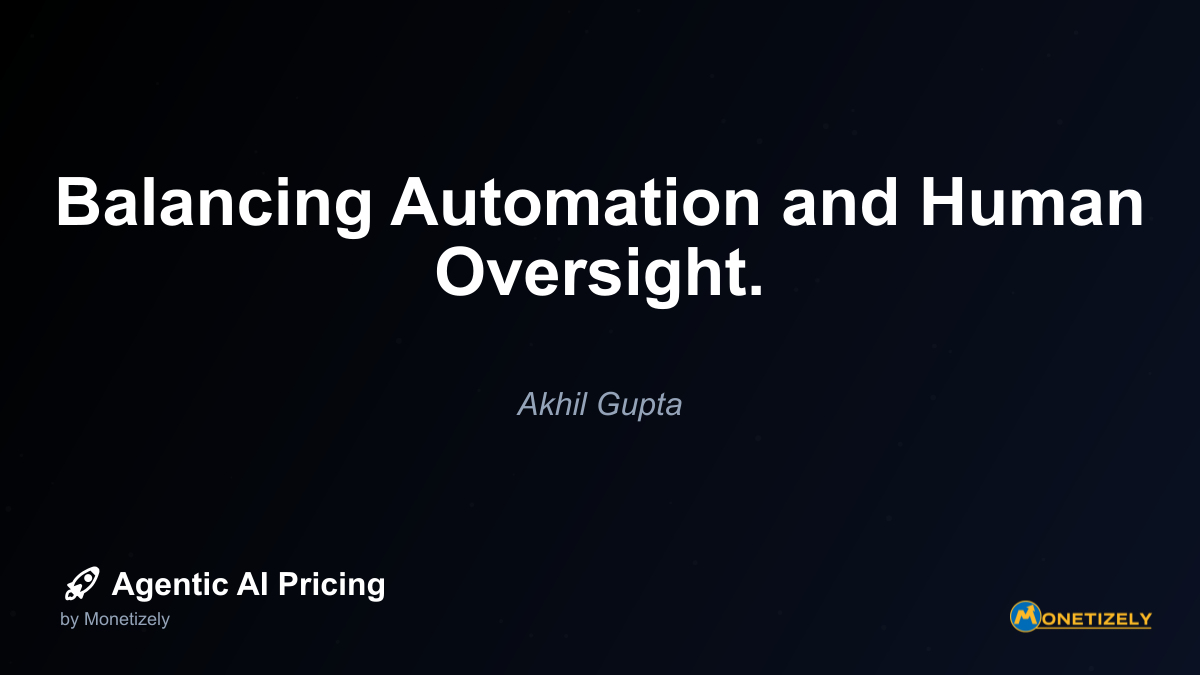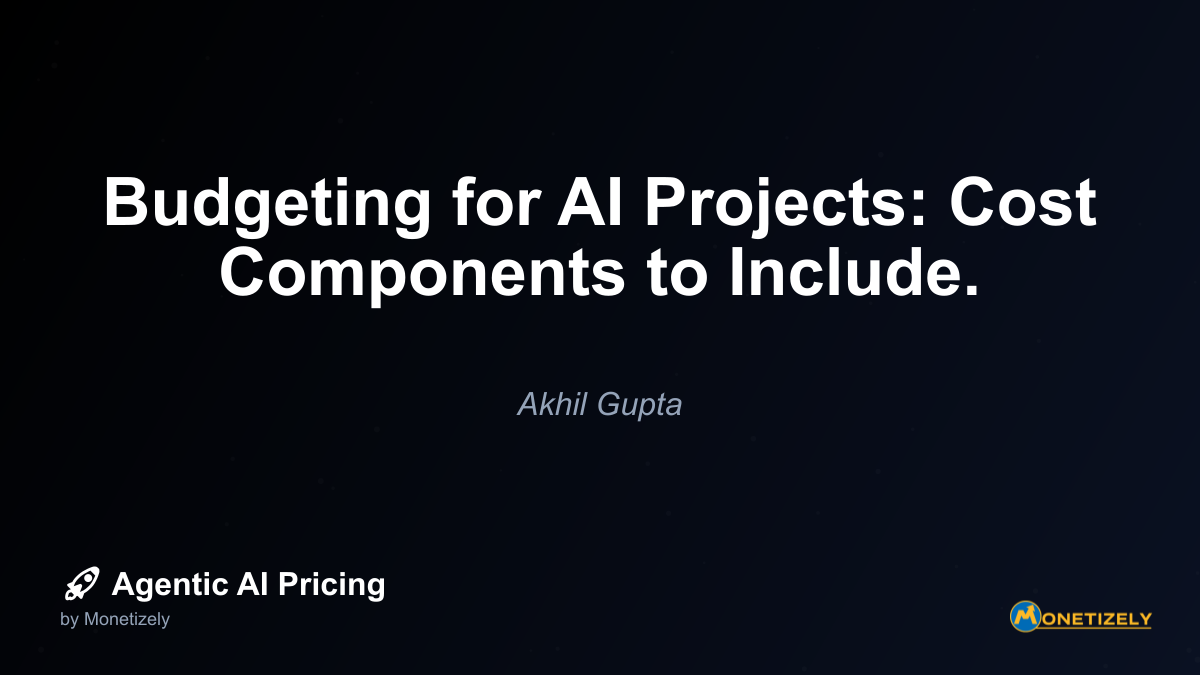· Akhil Gupta · Implementation Strategies · 9 min read
Ensuring ROI: Monitoring and Adjusting AI Deployments.
AI and SaaS Pricing Masterclass
Learn the art of strategic pricing directly from industry experts. Our comprehensive course provides frameworks and methodologies for optimizing your pricing strategy in the evolving AI landscape. Earn a professional certification that can be imported directly to your LinkedIn profile.
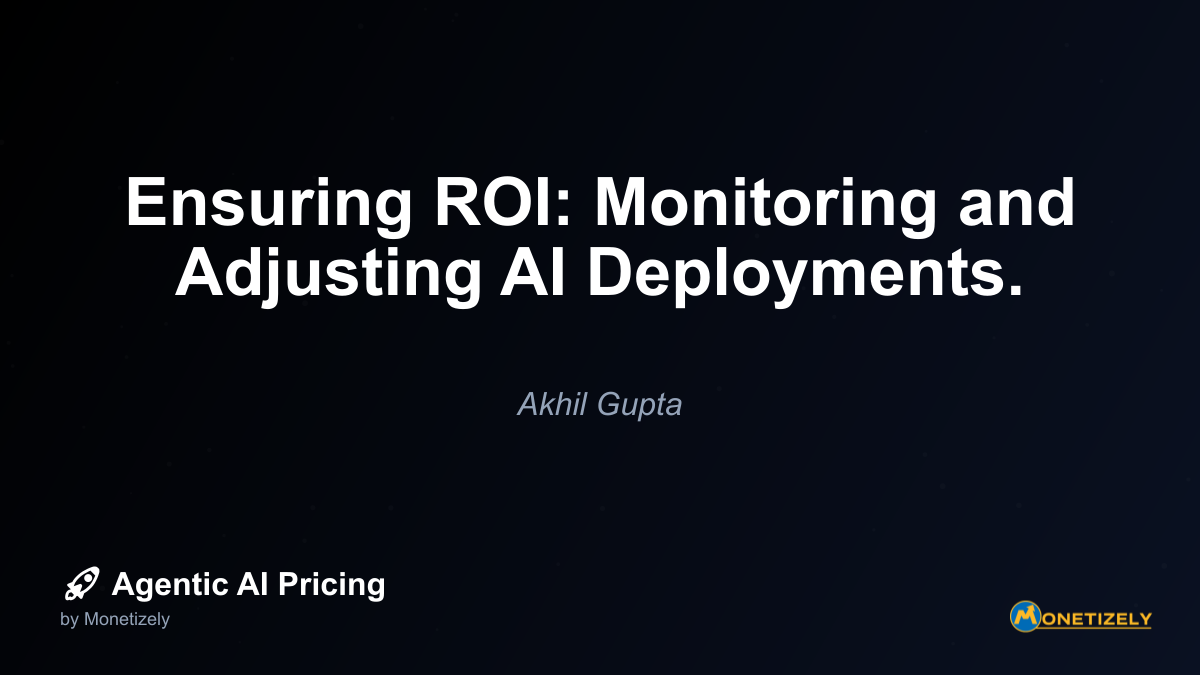
In today’s rapidly evolving technological landscape, deploying AI agents represents just the first step in a continuous journey toward maximizing return on investment. Organizations that excel in AI implementation understand that post-deployment monitoring and strategic adjustments are critical components of long-term success. The difference between AI investments that deliver exceptional value and those that underperform often comes down to systematic performance tracking and responsive optimization.
Why Monitoring AI Deployments Is Non-Negotiable
The implementation of agentic AI solutions comes with significant investment—not just in financial terms, but also in organizational resources, time, and strategic focus. Without proper monitoring mechanisms, these investments risk underperforming or, worse, becoming technological liabilities rather than assets.
Effective monitoring serves multiple crucial functions:
- Performance Validation: Confirms that AI systems are delivering the expected outcomes that justified their implementation
- Early Problem Detection: Identifies issues before they impact business operations or customer experience
- ROI Tracking: Provides concrete data on whether AI investments are generating appropriate returns
- Optimization Opportunities: Reveals potential areas for enhancement or expansion
- Resource Allocation Guidance: Informs decisions about where to increase or decrease AI-related investments
Organizations that neglect post-deployment monitoring essentially operate their AI systems blindly, missing both problems and opportunities that could significantly impact business results.
Essential Metrics for Monitoring AI Agent Performance
Establishing the right metrics framework is fundamental to effective AI monitoring. These metrics should align with both technical performance and business objectives.
Technical Performance Metrics
Accuracy and Precision: Measures how often the AI produces correct results and how reliable those results are. For example, in customer service AI agents, this might track the percentage of customer inquiries correctly categorized or resolved.
Response Time: Tracks how quickly the AI system processes inputs and delivers outputs. Slow response times can diminish user experience and operational efficiency.
Error Rates: Monitors how frequently the system produces incorrect outputs or fails to produce any output. This includes both technical errors and decision-making mistakes.
System Uptime: Records the percentage of time the AI system is operational and accessible to users. Downtime directly impacts ROI by limiting the system’s ability to deliver value.
Resource Utilization: Measures computing resources (CPU, memory, bandwidth) consumed by the AI system, which impacts operational costs.
Business Impact Metrics
Cost Reduction: Quantifies savings in operational expenses, such as reduced labor costs or improved process efficiency.
Revenue Impact: Measures increased sales, improved conversion rates, or new revenue streams attributable to AI implementation.
Time Savings: Calculates hours saved through automation or enhanced decision-making processes.
Customer Satisfaction: Tracks improvements in customer experience metrics like Net Promoter Score (NPS) or customer satisfaction ratings.
Employee Productivity: Measures changes in output per employee when supported by AI systems.
Usage and Adoption Metrics
User Engagement: Tracks how frequently and extensively employees or customers interact with the AI system.
Feature Utilization: Monitors which AI capabilities are being used most frequently and which might be underutilized.
Adoption Rate: Measures the percentage of potential users who actively engage with the AI system.
User Feedback: Collects qualitative data on user satisfaction and suggestions for improvement.
Creating dashboards that integrate these metrics provides a comprehensive view of AI performance and helps identify areas requiring adjustment or optimization.
Building Effective AI Monitoring Dashboards
A well-designed monitoring dashboard serves as the command center for AI performance management. When designing these dashboards, consider the following best practices:
Dashboard Design Principles
Audience-Specific Views: Create different dashboard views for technical teams, business stakeholders, and executive leadership, each highlighting the metrics most relevant to their roles.
Real-Time Monitoring: Implement near real-time data updates for critical metrics that require immediate attention.
Trend Visualization: Display performance trends over time rather than just current values to provide context and help identify patterns.
Alert Thresholds: Establish automatic notifications when metrics fall outside acceptable ranges, enabling proactive intervention.
Comparative Analysis: Include benchmarks or baseline comparisons to help contextualize performance data.
Essential Dashboard Components
Executive Summary: High-level overview showing key performance indicators and ROI metrics.
Technical Performance Panel: Detailed view of system health, accuracy, and operational metrics.
Business Impact Tracker: Visualization of revenue, cost-saving, and efficiency metrics.
User Engagement Monitor: Data on adoption rates and usage patterns across different user segments.
Feature Performance Breakdown: Analysis of which AI capabilities are delivering the most value.
Cost Tracking: Monitoring of operational costs against budget projections.
Modern monitoring tools like Datadog, New Relic, or custom solutions built on platforms like Tableau or Power BI can be configured to create comprehensive AI performance dashboards. The key is ensuring that data collection is automated and that dashboards are regularly reviewed by both technical and business stakeholders.
Strategic Adjustment: Responding to Monitoring Insights
Collecting monitoring data only creates value when it drives actionable improvements. Organizations need structured processes for translating insights into strategic adjustments.
When to Consider Adjustments
Performance Degradation: When accuracy, response time, or other technical metrics show consistent decline.
Underutilization: When usage metrics reveal that certain features or capabilities are rarely accessed.
Cost Overruns: When operational costs exceed projections without proportional value delivery.
Missed Opportunities: When data suggests potential for expansion into new use cases or user groups.
User Frustration: When feedback or engagement metrics indicate dissatisfaction with current functionality.
Types of Strategic Adjustments
Feature Optimization
Feature Pruning: Deactivating or removing low-value features that consume resources without delivering proportional benefits.
Feature Enhancement: Improving existing capabilities based on usage patterns and user feedback.
Retraining and Refinement: Updating AI models with new data to improve accuracy and relevance.
Resource Allocation
Computing Resource Adjustment: Scaling computing resources up or down based on actual usage patterns and performance requirements.
Team Focus Shifting: Reallocating development and support resources to high-impact areas.
Budget Reallocation: Adjusting financial investments based on ROI data from different AI capabilities.
Use Case Expansion or Contraction
Scaling Successful Applications: Expanding high-performing AI applications to new departments, regions, or customer segments.
Consolidating Underperforming Areas: Reducing scope in areas where AI has not delivered expected value.
Pivoting to Adjacent Opportunities: Redirecting resources to related use cases that show greater potential based on initial results.
Case Study: Financial Service Provider’s AI Chatbot Optimization
A leading financial services company implemented an AI chatbot to handle customer inquiries. Initial monitoring revealed several insights that led to strategic adjustments:
Initial Monitoring Findings:
- The chatbot successfully handled 65% of inquiries, below the 80% target
- Customer satisfaction scores for chatbot interactions were 20% lower than human agent interactions
- Certain complex transaction inquiries consistently resulted in escalations
- Simple balance and statement requests were handled with 98% accuracy
- Peak usage occurred between 8-10 AM and 6-8 PM
Strategic Adjustments Made:
- Reconfigured the chatbot to immediately route complex transaction inquiries to human agents
- Expanded the chatbot’s capabilities for handling balance and statement requests
- Added additional computing resources during peak usage periods
- Simplified the conversation flow based on user interaction patterns
- Implemented a feedback mechanism for continuous improvement
Results After Six Months:
- Overall successful resolution rate increased to 82%
- Customer satisfaction scores improved to within 5% of human agent interactions
- Cost per customer inquiry decreased by 35%
- Agent time was redirected to complex issues requiring human expertise
- ROI on the chatbot investment increased by 45%
This case demonstrates how systematic monitoring and strategic adjustments transformed an initially underperforming AI implementation into a high-value asset.
Implementing a Continuous Improvement Cycle
Rather than treating adjustments as one-time events, organizations should establish a continuous improvement cycle for their AI deployments:
1. Regular Review Sessions
Schedule structured reviews of AI performance dashboards with cross-functional teams including:
- Technical AI specialists who can interpret performance data
- Business stakeholders who understand value metrics
- End users who can provide practical feedback
- Financial analysts who can assess ROI implications
These reviews should occur at regular intervals—weekly for new deployments, monthly for stable systems, and quarterly for strategic reassessments.
2. Prioritization Framework
Develop a consistent methodology for prioritizing potential adjustments based on:
- Expected ROI improvement
- Implementation effort required
- Strategic alignment with business objectives
- Risk assessment
- User impact
This ensures that limited resources are directed toward the highest-value improvements.
3. Experimentation Approach
Implement adjustments using an experimentation mindset:
- Start with controlled pilots when possible
- Establish clear success metrics before implementation
- Set specific timeframes for evaluation
- Compare results against baseline performance
- Document lessons learned for future reference
4. Feedback Integration
Create structured processes for collecting and incorporating feedback from:
- Direct users of the AI system
- Indirect beneficiaries of AI outputs
- Technical support teams
- Business performance data
- Competitive analysis
This multi-source feedback approach provides a comprehensive view of potential improvement areas.
Overcoming Common Monitoring and Adjustment Challenges
Organizations often encounter obstacles when implementing effective monitoring and adjustment processes. Here are strategies for addressing common challenges:
Data Quality Issues
Challenge: Incomplete, inconsistent, or inaccurate data undermining monitoring effectiveness.
Solution: Implement data validation processes, establish data quality metrics, and create alerts for potential data integrity issues. Regularly audit data collection mechanisms to ensure reliability.
Organizational Resistance
Challenge: Resistance to making adjustments due to emotional investment in initial implementation decisions.
Solution: Foster a data-driven culture that normalizes continuous improvement, celebrate successful adjustments, and emphasize learning rather than criticism when making changes.
Technical Complexity
Challenge: Difficulty in implementing monitoring systems that track both technical and business metrics.
Solution: Start with a minimal viable monitoring approach focused on critical metrics, then expand gradually. Consider partnering with specialized AI operations vendors for more sophisticated monitoring capabilities.
Attribution Challenges
Challenge: Difficulty in accurately attributing business outcomes to specific AI capabilities.
Solution: Implement controlled experiments when possible, use advanced attribution modeling, and combine quantitative metrics with qualitative feedback to create a more complete picture.
Resource Constraints
Challenge: Limited resources for implementing comprehensive monitoring and making necessary adjustments.
Solution: Prioritize monitoring for high-value or high-risk AI applications, leverage automated monitoring tools, and build adjustment capabilities into initial implementation plans.
Future-Proofing Your AI Monitoring Approach
As AI technologies and business environments evolve, monitoring and adjustment strategies must adapt accordingly. Forward-thinking organizations should prepare for:
Emerging Monitoring Considerations
AI Explainability Monitoring: As regulations around AI transparency increase, monitoring systems will need to track and report on explainability metrics.
Ethical Performance Tracking: Monitoring for bias, fairness, and ethical considerations will become increasingly important.
Cross-System Impact Analysis: As organizations deploy multiple AI systems, monitoring their interactions and combined impact will grow in importance.
Competitive Benchmarking: Comparing AI performance against industry standards and competitor capabilities will become a standard monitoring practice.
Evolving Adjustment Strategies
Automated Adjustments: Implementing AI systems that can self-optimize based on performance data.
Ecosystem Integration: Adjusting AI systems to work more effectively within broader technology ecosystems.
Business Model Alignment: Evolving AI capabilities to support new business models and revenue streams.
Skills Development: Building internal capabilities to respond more effectively to monitoring insights.
Conclusion: The Continuous Path to AI ROI Optimization
Monitoring and adjusting AI deployments represents not just a technical necessity but a strategic imperative for organizations seeking to maximize their return on AI investments. The most successful organizations view deployment not as the finish line but as the starting point of an ongoing optimization journey.
By implementing comprehensive monitoring systems, establishing structured adjustment processes, and fostering a culture of continuous improvement, organizations can transform their AI investments from static implementations into dynamic assets that continuously evolve to deliver greater value.
The path to optimal AI ROI is iterative rather than linear. Each monitoring insight creates an opportunity for improvement, and each strategic adjustment opens new possibilities for value creation. Organizations that excel in this continuous optimization cycle will find themselves with AI systems that not only meet their initial objectives but consistently exceed them over time.
As the AI landscape continues to evolve at a rapid pace, this capability for systematic monitoring and strategic adjustment will increasingly separate AI leaders from followers—and determine which organizations capture the full potential value from their AI investments.
Co-Founder & COO
Akhil is an Engineering leader with over 16+ years of experience in building, managing and scaling web-scale, high throughput enterprise applications and teams. He has worked with and led technology teams at FabAlley, BuildSupply and Healthians. He is a graduate from Delhi College of Engineering and UC Berkeley certified CTO.
Pricing Strategy Audit
Let our experts analyze your current pricing strategy and identify opportunities for improvement. Our data-driven assessment will help you unlock untapped revenue potential and optimize your AI pricing approach.

